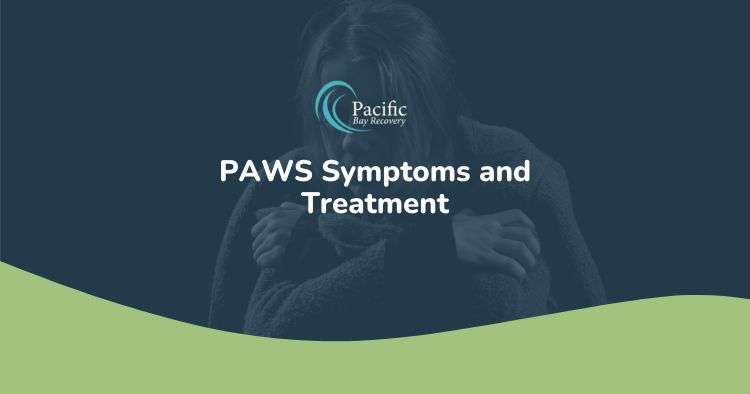To understand PAWS (Post-Acute Withdrawal Syndrome), one first must understand the two phases of detoxification or withdrawal symptoms. Stage one of detoxification, acute withdrawal, is mainly physical withdrawal PAWS symptoms, lasting from a couple of days up to two weeks. Acute symptoms of withdrawal are the initial or immediate withdrawal symptoms occurring upon rapid reduction or sudden cessation of using addictive substances, which include alcohol.
Stage two of detox, referred to as PAWS (post-acute withdrawal syndrome), happens as a person’s brain re-calibrates after active addiction. The symptoms of post-acute withdrawal, unlike acute withdrawal, (mainly physical withdrawal symptoms), are mainly emotional and psychological symptoms. Depending upon the duration and intensity of alcohol or other types of drug use, post-acute withdrawal is notorious for lasting several months. Typically, post-acute withdrawal symptoms last from one to two years; but the frequency and severity of symptoms usually dissipate as time passes without using addictive substances.
Who Is Most Vulnerable to PAWS Symptoms?
PAWS happens after the stage of acute withdrawal and naturally occurs as the patient’s brain gradually goes back to normal over time. As a person’s brain chemicals start regulating, their symptoms might fluctuate as their brain tries to search for a healthy equilibrium. Post-Acute Withdrawal Syndrome is the brain’s method of correcting chemical imbalances experienced during active addiction. Post-Acute Withdrawal Syndrome usually occurs more intensely and commonly among those who have Opioid, Benzodiazepine, or alcohol addictions.
What Are Post Acute Withdrawal Symptoms?
There are a variety of symptoms related to PAWS. Let’s explore these below:
Mood swings: The chronic drug user’s brain, which includes those taking medicine under a physician’s supervision, has adapted to a consistent mood-altering substance supply. Once the substance has been removed, periods of depression or mania may occur for no reason as the brain tries to rebalance itself.
Anhedonia: Even though they function in various ways, pretty much all addictive drugs, and a lot of medications such as antidepressants, have the end outcome—at least in the short term—of boosting neural pathways and neurotransmitters that make a user feel good. Or else, why would they take them? However, when those medications and drugs are stopped, it may take time for their brain to generate regular levels of those feel-good chemicals on their own again. Until they do, the person might discover that nothing seems interesting or fun anymore – even those activities they once enjoyed.
Anxiety: For both patients and addicts, cessation of a medication or drug is a huge life change. So, it’s understandable that there may be a good bit of anxiety, even panic attacks, accompanying that shift. Also, drugs like BZDs and alcohol, chronically inhibiting brain activity result in anxiety-prone, hyperexcitable states once they’re stopped.
Insomnia: A lot of psychoactive medications and drugs impact sleep patterns, and the person’s brain can adapt to long-term use. When those drugs are stopped, it takes time to re-establish a healthy sleep pattern.
Sleep disturbances: A subconscious desire to take drugs or alcohol, or to resume some element of a drug-using lifestyle, may manifest themselves in realistic, vivid dreams. Although these types of dreams might be disturbing to someone in recovery, they aren’t a warning of an impending relapse, yet merely a reflection of how deeply a drug-taking compulsion might be ingrained in their mind.
Cognitive impairment: Similar to mood changes, this is yet another neurotransmitter imbalance symptom. It’s vital to keep in mind that maintaining concentration and difficulties in thinking clearly are generally temporary and not an indication of permanent brain damage.
Fatigue and depression: A lot of people who quit long-term medications or chronic drug habits suffer such intense feelings of fatigue and depression that they match the criteria for Chronic Fatigue Syndrome or Major Depressive Disorder.
Drug cravings: Someone who has PAWS often has intermittent cravings for the medication or drug they took previously. Because the most intense physical symptoms of withdrawal have subsided, the person might feel physically healthy yet continuously experience negative psychological symptoms, making the return to drug abuse seem like a good idea.
Sensitivity to stress: A lot of people who deal with the impact of PAWS discover that their daily stress threshold is extremely low. Setbacks or trivial irritations might feel, to them, like the end of the world.
Though post-acute withdrawal syndrome may be a difficult process while the body and brain start healing and reorienting themselves to life without using alcohol or other types of drugs, help is out there. There are outpatient treatment services available like Pacific Bay Recovery to steer you through the phase of post-acute withdrawal during recovery in order to prevent relapse. Patients can achieve whole recovery by contacting us today at (619) 350-8220 to learn more about their options for rehab.


